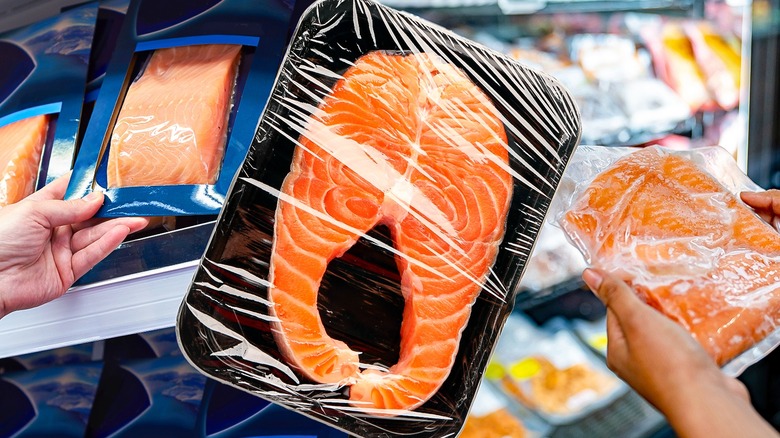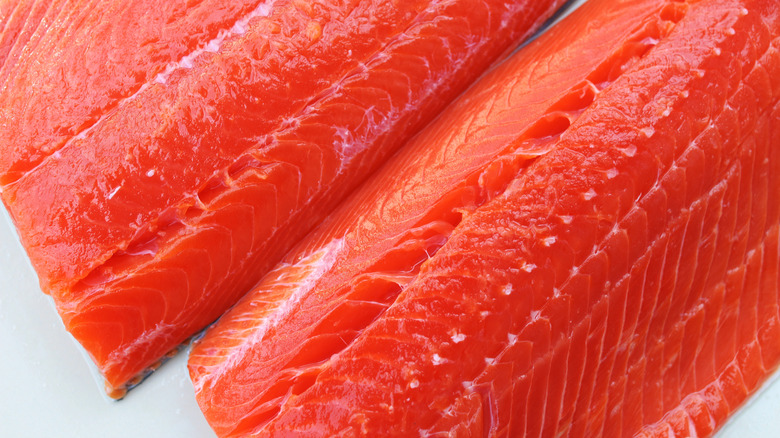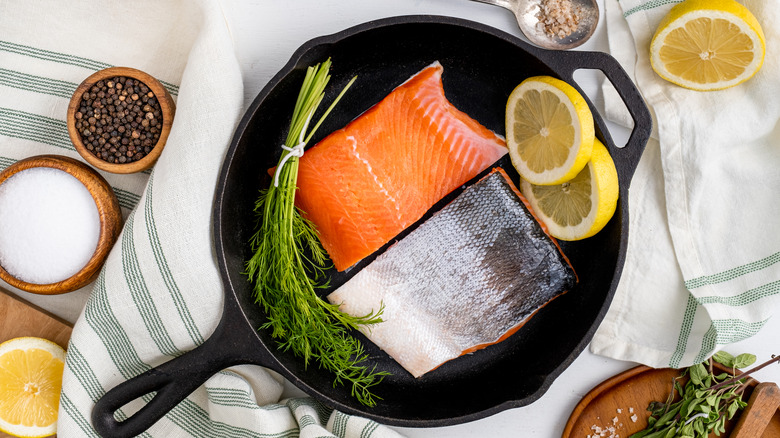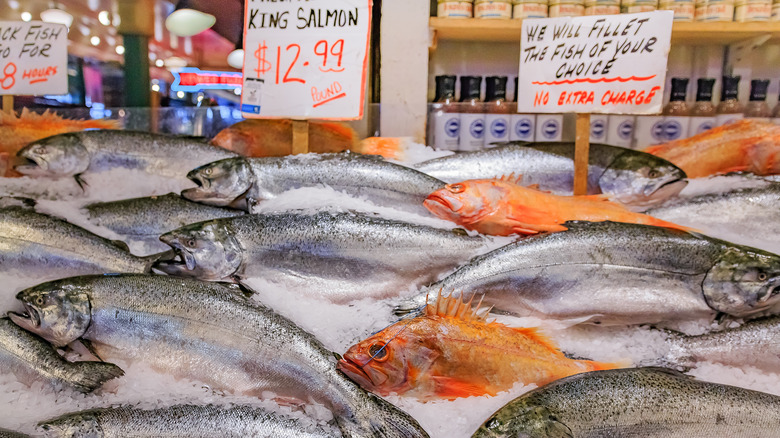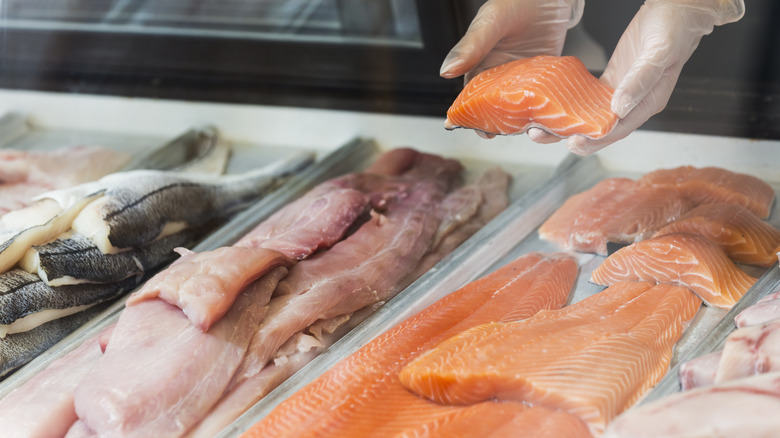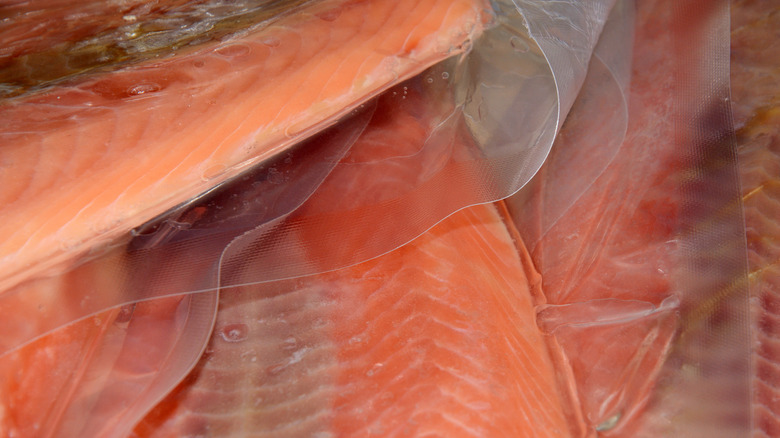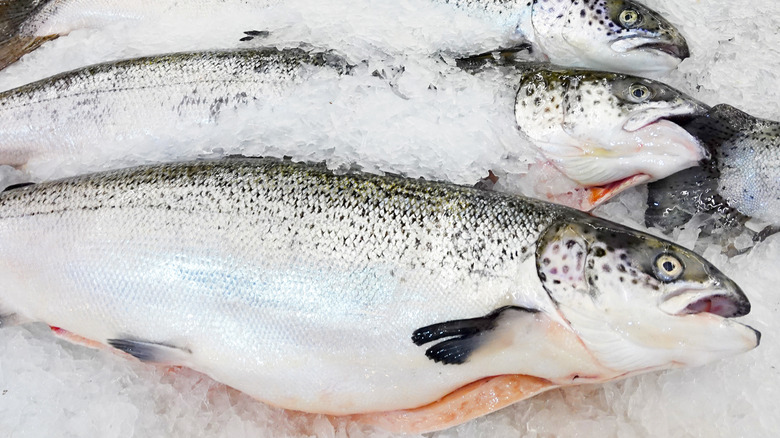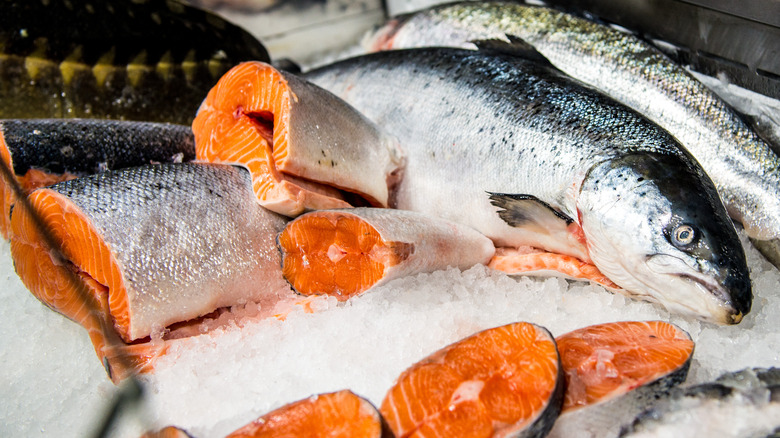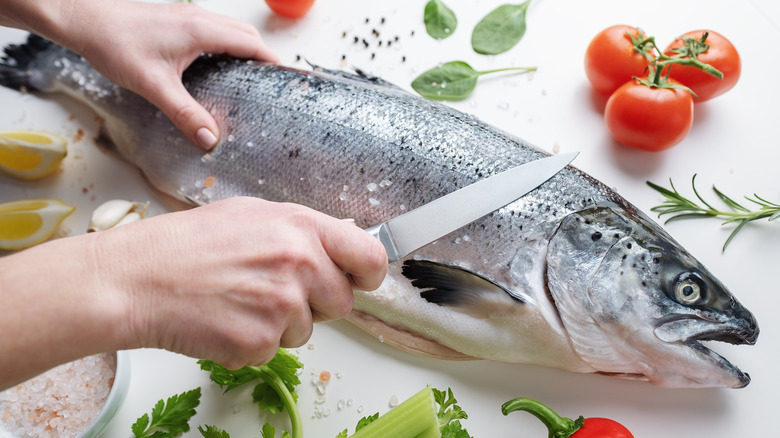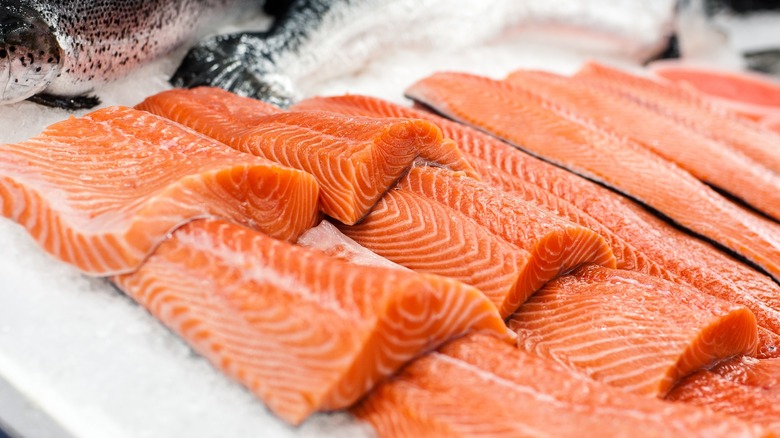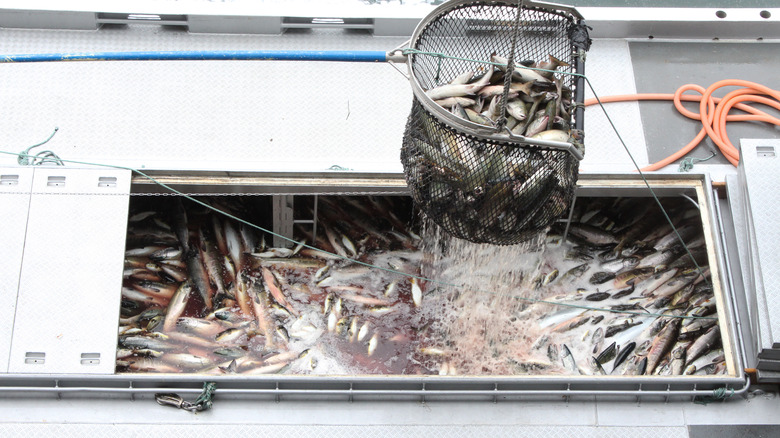12 Tips And Tricks You Need When Shopping For Quality Salmon
When I was running my restaurants, I enjoyed a privilege that few other chefs could boast even here on Canada's seafood-centric East Coast. I was situated just a few miles from a highly-regarded aquaculture facility and could purchase from them directly. Twice a week, shortly after lunch, I would receive salmon that had been pulled from the water just a few hours earlier.
Most of us will never have that opportunity, but even the salmon at your local supermarkets and specialty fishmongers will vary widely in quality and freshness. Some well-established guidelines can help you recognize freshness when you see it, but salmon presents a few additional quirks that can complicate your buying decision.
Salmon will seldom be the low-cost option when you're in the mood for fish, but it is one of the most versatile and rewarding choices. Speaking as a trained chef and longtime seafood lover, here is how to choose the best and freshest.
Deciding between farmed and wild-caught salmon
Farmed salmon gets a bad rap, and many shoppers avoid it. It is certainly true that aquaculture can be problematic, but farmed fish shouldn't be an automatic "nope." The reality is more nuanced, and farmed fish can relieve pressure on wild stocks, especially in high-demand species like salmon. It's also worth noting that some wild fisheries are themselves rated as "Avoid" by Seafood Watch.
There are differences between wild and farmed salmon, though you will seldom make that direct apples-to-apples comparison. Most farmed salmon is the Atlantic species, and wild Atlantic salmon is only harvested in small quantities in a few European ecosystems. Coho salmon is farmed in modest quantities in Chile, but otherwise, you are unlikely to see a straight-up choice between wild or farmed salmon of the same species (Spoiler: Farmed Coho is also on Seafood Watch's Avoid list).
Usually, your choice will be between farmed Atlantic salmon or wild Pacific salmon. There is a case to be made for either option, depending on how you weigh factors like price and sustainability, and on a given day one or the other might be your better, fresher option.
Know your seafood certifications, and what they mean
If issues of ethics, sustainability, and environmental impact play a role in your food-buying decisions, you will have plenty of guidance in your choice of salmon. Several organizations offer standards and certifications that can help you identify your best choices.
These certifications include the Marine Stewardship Council (MSC) for wild-caught fish; the Aquaculture Stewardship Council (ASC) for farmed fish; the Global Dialog on Seafood Traceability (GDST); the Global Seafood Alliance's Best Aquaculture Practices (BAP) and Best Seafood Practices (BSP) certifications; OceanWise; and Friend of the Sea.
These certifications vary in their focuses, but most revolve around how fish are harvested or raised, and what impacts that fishery or aquaculture method has on the environment or other species. The GDST takes a different tack, looking at the traceability of seafood (that provides accountability, and a defense against seafood fraud). Aside from looking at specific certifications (and by all means, look them up and learn what they all mean, tools like Monterey Bay Aquarium's Seafood Watch can help you choose fish from sustainable sources even when they don't have an explicit certification.
Understand the different kinds of salmon
There is only one kind of Atlantic salmon, known to scientists as Salmo salar. It is what's called a "type species" in biology, meaning essentially that "this is what we call a salmon, and so is everything that closely resembles it."
Pacific salmon belong to a separate genus called Oncorhynchus, and there are five of them you may see at your local market. While everyone has an opinion on the subject, by consensus the best of the salmon types is the King or Chinook salmon. It is the biggest and richest-tasting Pacific species, but also (sadly) the rarest and costliest. Sockeye also commands a premium because of its richness. Coho is the mid-grade Pacific salmon, and probably the closest counterpart to Atlantic salmon. Pink and chum salmon are generally considered to be the lowest in quality, though they are still perfectly good when very fresh.
That is an important point because while some species are better than others in theory it's not the whole story. Freshness, and the handling they have received since they were landed or harvested, have a lot to do with the quality of the salmon that reaches your plate.
Just because salmon isn't frozen doesn't mean it's fresh
One of the very first things you need to know when you go to buy salmon is that the rosy filets resting on ice in that display case are not necessarily "fresh." Fresh, where fish is concerned, means it has never been frozen. Even in the modern era of refrigerated trucks and air freight, it is hard to get truly fresh fish to every market that wants it. Fresh fish is super-perishable, there's just no way around that fact.
Instead, most forms of seafood — including salmon, shrimp, and essentially anything other than mollusks — are blast-frozen for shipping purposes. As long as they are packaged properly, frozen whole fish, filets, or individual portions can be shipped worldwide without the almost immediate loss of quality you'd see with fresh fish. Even high-end supermarkets and boutique fishmongers will usually bring in frozen salmon, and then thaw it (ideally, under carefully controlled conditions) before putting it on display.
Frozen salmon isn't a compromise where quality is concerned
Unless you live next door to the fish plant, frozen is often the best way to buy your salmon. We would all like to think that fresh is better, but that's not necessarily true where seafood is concerned.
Buying frozen salmon is not a compromise at all (that's a salmon myth). A salmon that has been blast-frozen on the boat, or in an aquaculture operation's processing facility, stays exactly as fresh as it was when it came out of the water. In fact, salmon destined for sushi should always be frozen, because that's how the FDA suggests protecting against parasites.
Your best choice is salmon that's vacuum-sealed. Avoid packages that have lost their seal, or show frozen liquid inside the packaging (a sign that it has thawed at least partially at some point). If you buy individual frozen portions in a bag, make sure they have not stuck together. If so, that's also a sign of improper handling and partial thawing. Buying your salmon fresh (or thawed) means you would ideally cook it that same day. Getting your salmon frozen gives you more flexibility, and lets you keep it on hand for when the mood strikes.
Know how to identify fresh fish
If you are going to buy your fish fresh or thawed, there are several signs to help tell you when it is at its best. These are the same for salmon as for most other fish, so they're worth knowing if you love seafood.
The eyes should be round and clear, not sunken and cloudy. The gills should be a deep, vivid red. If you brush your hand along the side of a whole fish, or the skin side of a filet, scales should not brush off easily but stay attached to the skin. If you poke it with a finger, the dimple from your fingertip should rebound and not stay visible in the flesh.
A final test, which — like the "finger-dimple test" — works even for skinless portions, is to take a sniff of the salmon before you decide to buy it. It should smell fresh, with just a hint of brine, and not at all "fishy." As some people express that thought, "Good fish should smell like high tide, not low tide." This is arguably the most important test of all, and that is not just our opinion. Michelin-starred chef Eric Ripert also endorses the sniff test, and he made his name largely on the strength of his seafood.
Start with a whole salmon when you can
Buying a whole salmon or even a full filet will give you enough to feed a large party, for a celebratory sit-down meal. But even if you are only planning a meal for one or two, it is useful to start with a whole salmon when you can. Why?
Well, for starters, many of the leading signs of freshness in fish are only visible when it is still whole (celebrated chef Thomas Keller works a lot with whole fish, partly for this reason). You may prefer boneless, skinless portions precisely because they don't have eyeballs, for example, but the eyes can convey a lot about freshness.
There will not always be a whole salmon in the display, and if there is, it may not be from the same batch as the prepared portions offered for sale. Fishmongers who cut their own, even if the display is full of portions and filets, may be able to bring out a whole fish from the same batch to show you so you can satisfy yourself about its freshness. Just do not do that at one of their busiest times of the day. "Knowledgeable customer" is the impression you want to create, not "entitled pain in the butt."
Ask for the salmon to be scaled before you buy it
Okay, we get it. Not everybody loves the skin. But for those of us who do, there are plenty of good reasons to eat salmon skin. It is packed with flavor and contains a concentrated wallop of omega-3 fatty acids, and when its fish skin is properly pan-seared, it is crisp and delightful. Salmon will grill better with the skin on, too.
If you are buying a whole fish or a full filet, it is relatively easy (though messy) to scale your own at home. Set it out on a sheet of paper, and scrape the scales away, from tail to head, until it is clean. Unfortunately, that is not easy to do if you have bought individual portions, and you then discover that the salmon wasn't scaled before the store portioned it. Grrr!
If the presentation of the finished dish does not depend on the skin, you can just strip it from your portions. But for those who love the skin, and consider it the best part, this is an unappealing alternative. Unless you routinely buy your salmon in large portions, it saves time and trouble (and cleanup) to have your fishmonger scale it for you.
You can't judge the quality of salmon by its color
One of the things that sets salmon apart from other fish is its vivid color. It can range from a pastel pink to a vivid orange-red, depending on the species, and it is undeniably attractive. But one thing it is not is an indication of freshness or wild-caught versus farmed.
Salmon gets its signature pink color from a pigment called astaxanthin, found in the shells of the small shrimp and other crustaceans they eat in the wild. In farmed salmon, it is provided through their feedstock. Aquaculture operations are free to crank up the astaxanthin in their feed, produce boldly pink salmon, and bring it to market. The only question is whether they would command enough of a premium to make that effort worthwhile.
Even wild salmon of the same species can vary widely in color, depending on what they have eaten during the adult phase of their life cycle, and how much astaxanthin was present in those prey species. The much-loved King salmon can even be white. So while the pink color is attractive on your plate, the notion that the salmon's color means anything more is a myth you should ignore.
Assess the quality of the fishmonger, as well as the salmon
How a fish is handled has a massive impact on its quality. Since you can not personally follow a filet's journey from the processing plant to the retail showcase, you will need to rely on secondary data — some of it from your own senses — to infer how well a fishmonger handles its wares.
One sign to look for when choosing a fishmonger is popularity. Online reviews can be manipulated, but lines out the door all weekend tell their own story. Also, separate the location from the shop: A retailer in a popular tourist destination may well be good, but if a place in an out-of-the-way neighborhood is equally busy you know the fish is the only reason.
Aside from that, be observant. Is the shop clean? Is it cold? Does it smell fishy (it really, really shouldn't)? Are the cases clean and well-drained, and is the ice changed frequently? Do the thermometers in the display cases show temperatures barely above freezing? Are the staff knowledgeable? It's not a hard-and-fast rule, but retailers who show professionalism and attention to detail in their storefronts are likely to be equally scrupulous in their handling of the fish.
Ask about the provenance of the salmon you buy
This is a smart thing to question because it does a couple of things. First, it means that you are more informed about where your salmon came from, and how well its journey has been documented. Second, it is a good test of your fishmonger: A shrug, or the name of a wholesale distributor, is really not a good answer.
A good fishmonger will absolutely know this, for your salmon and most other things in the shop. As long as they are not swamped with customers, most will happily explain why they've chosen that particular supplier over others, and how and where the fish are caught or farmed.
There has been a big push toward traceability in the seafood industry, partly as a way to combat fish fraud and partly as a way to ensure transparency and accountability. That is what the GDST certification is for, and many producers also follow an established supply-chain management data standard, called EPCIS, that documents every step from the producer to you. As a consumer, you do not necessarily need that level of detail, but if your fishmonger can provide it, it is a strong sign that your salmon was handled correctly.
If you eat a lot of salmon, cultivate a relationship with your fishmonger
Anyone who eats a lot of salmon, or even fish in general, should try to build a relationship with at least one top-quality fishmonger in their area. You do not need to become lifelong besties or bring birthday gifts for their kids, but being recognized as "a regular" is just the starting point.
Ask them questions, and solicit their advice. Have them recommend a premium product to you occasionally — and buy it — for special occasions. And always remember that any relationship is a two-way street. Take care to learn their busy times, and don't hang around trying to be their BFF while they are getting run off their feet.
Giving back is a powerful relationship-building tool. When they give good service, post reviews on Google or Yelp. Give them shout-outs on your social media, recommend them to your friends, and tag them when you post that amazing salmon dinner on Instagram. Once you have built up a relationship, you can make special requests ("save me the strips of belly meat?"), or ask them to let you know when they have something special coming in; maybe the first Kings of the year, or some ultra-rare wild-caught Atlantic salmon from Europe. Even the guy at the supermarket, if he likes you, can steer you to the best and freshest of what is in his case (and, yes, some supermarkets do have better seafood than others).
